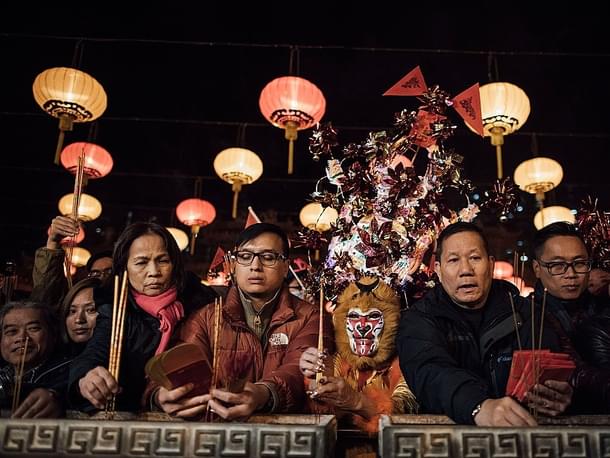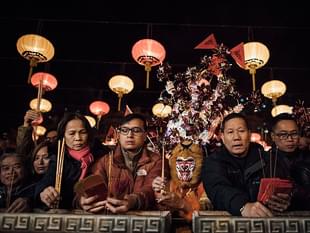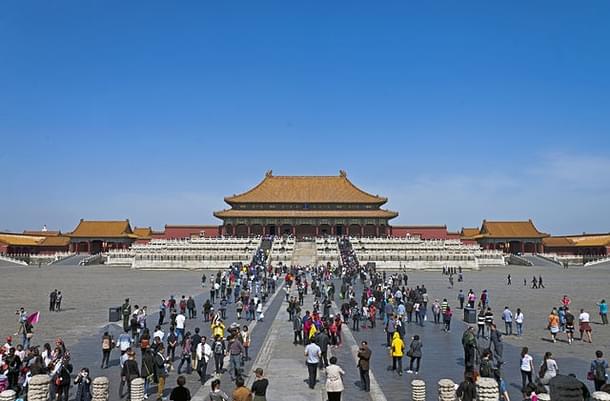World
Chinese Culture As The New Soft Power Currency
Namaste Ni Hao1
Jan 09, 2018, 01:09 PM | Updated 01:09 PM IST
Save & read from anywhere!
Bookmark stories for easy access on any device or the Swarajya app.


Recent news of China’s economic slowdown has been filling newsrooms and online media worldwide. Finance Ministers and Central Bank governors of large economies have been voicing their concern over this slowdown which could affect the global economy. Despite the market slowdown, mood about China seems steady.
Tourists still flock to China to “experience” Chinese tradition and culture while marveling at mega cities like Shanghai. Despite the many issues of human rights abuses, censorship and suppression of dissent, China has managed a great victory by diverting the world’s attention to itself as a strong economic, political and cultural power.

This phenomenon begs our attention and the following questions arise: Why is the world fixated on China? Why is everyone singing China’s tune? How has China successfully marketed itself to the world? Can India gain insights into promotion of its culture like China?
In search of a good PR strategy: image correction within and outside
While it was rising in the economic sphere, China felt its presence on the world stage restricted. In order to expand its footprint globally, China started to use what Joseph S. Nye coined “soft power”. “Soft power” is the ability to co-opt people and influence them, to achieve political ends through attraction rather than coercion or force. Compared with “hard power” (usually military might), “soft power” has a subtle and positive ability to shape agenda in global politics.
This move towards the use of soft power actually reflects China’s understanding of its impact on the world that it could use to its own advantage. Realizing the importance of soft power through culture, the Official People’s Daily declared that “we cannot be soft on soft power” and suggested that instead of remaining a mere “assembly plant” , China must look to actively export cultural content to strengthen itself. It called for culture, politics and economy to move at the same pace in strengthening China.
The idea behind soft power usage was to address/offset three complications arising with its rise. The first is China’s perception that it continues to suffer the stigma of Western-imposed negativity , the sense of historical wrong meted out to them and so China’s own cultural influence needs to be mobilized to counter this dominant Western portrayal of China. It feels the need of protecting its “cultural security”.
Secondly, within the international domain, China’s image as an economic powerhouse has been running simultaneously with the image of an authoritarian One Party System, poor track record of human rights and freedom of expression. In order to correct this perception, China has mounted a major public relations offensive in the recent years, heavily investing in the “Culture Industry” of China.
Thirdly, within China, the Party is making a case for its “right to rule”, as a legitimate authority to govern China. In this bargain, it is increasingly making use of what Elizabeth Perry calls “Cultural Governance”. Dr. Perry’s hypothesis is that China is making use of Cultural Governance strategies, or the deployment of symbolic resources as an instrument of political authority.
Having shifted from the traditional Marxist- Maoist basis of legitimation to a marketised economy, the Party is now compelled to position itself to reflect favorably that it still holds the reins of legitimacy. This it does by shoring up the glorious history of the Chinese civilization and the Party as its true guardian.
Building the Culture Industry:
Soft power has become strategically important for China and is regarded an important component of its “comprehensive national power” (zōnghé guólì (综合国力); a measure of its own national power. The Olympic Games of 2008 has been considered the first watershed moment of announcing China’s grand entry and large scale projection of its soft power.
Quoting heavily from Confucian Analects and display of eye-catching logo based on the ancient art of seal calligraphy, various dance forms, The Party declared to be the vanguard of a cultural tradition alive and kicking in contemporary times.
The need for a greater cultural soft power has been repeatedly emphasized by leaders in China, including outgoing President Hu Jintao in his address to the 18th National Congress of the Chinese Communist Party (CCP) in 2012. He emphasized that “culture is the lifeblood of the nation” and called for promoting “traditional” Chinese culture, making references to the “great revival of the Chinese nation” as the goal.
This was taken one step further by the current President Xi Jinping and “enhancing” of China’s “cultural soft power” was the subject of the twelfth collective study session of the Chinese Communist Party’s politburo on 31 December. While taking over from his predecessor Hu Jintao, President Xi urged that “the great revival of the Chinese nation is the greatest dream of the Chinese nation in modern history.” In 2014 he announced his agenda as follows:” we should increase China’s soft power, give a good Chinese narrative, and better communicate China’s messages to the world”.
These rhetorics notwithstanding has paved a way to the establishment of a full-fledged cultural industry manufactured in China to the outside world using the newly emerging media, traditional arts, and crafts, tourism, Chinese traditions, language, and education.
The nerve center of this cultural industry is the State Council Information Office (SCIO) located in Beijing. This is the most secretive office in the vast and intricately webbed Propaganda Department. While it primarily acts as the key censoring body and media watchdog in China, it also is the key player in the cultural export of China and its new image management agency.
Yearly it convenes an annual conference called “our soft-power strategy” and defines the ideas that are to be propagated abroad and the coordination of information with other players in this mechanism.
This exercise runs on a massive $10 billion annually while in contrast the U.S Department of State spent $666 million on public diplomacy in 2014. This gives the scale to which the Chinese have taken this image building exercise to a next level.
Hard selling soft power:
This exercise to understand the explosion of Cultural export by China would be futile without a discussion on some of their key target areas and the work being carried out :
Confucius Institutes:
In a previous article (can be found here) about the appropriation of Confucius by the Communist Party as a cultural governance strategy, since 2004 , the Government has been globally exporting Confucius as a true “Chinese” symbol through the opening Confucius Institutes in partnership with foreign universities.

It is modeled on the Goethe Institute and Alliance Française of Germany and France respectively. An estimate according to Frankfurt –based researcher Falk Hartig quotes around 475 institutes and 850 smaller Confucian classrooms across West, Asia-Pacific, and Africa.
Language as (soft) power:
Recognizing the importance and role of language in increasing its global cultural attractiveness, China has been aggressively promoting the study of Chinese language all over the world. It does this in two important ways; firstly through the Confucius Institutes which act as a perfect conduit of Chinese language and culture and secondly through generous scholarships to study in China.
An article in Foreign Affairs projects around 300,000 foreign students studying in Chinese universities. Every year the China Scholarship Council (CSC) offers around 20,000 scholarships to foreign students.
While the major thrust has been providing support for short-term and long-term language courses, an increasing number of students are being pulled from all over to newly created “English-taught” Programs. These programs are specifically targeted at foreign students aiming to get a master’s degree or Ph.D. in different fields, in English as medium(along with Chinese language coaching).
The perks include a monthly stipend of 3000RMB(amounts to roughly 30,000 INR) , free housing and free medical insurance . The Confucius Scholarship is another scholarship offering Bachelor’s and Master’s degree to “cultivate qualified Chinese language teachers and talented students of Chinese language”. While the goal here is to impart Chinese speaking and writing skills, the latent focus is to change the hearts and minds of “foreigners” towards China.
The language and English-taught Programs serve a great deal in the growing superiority game being played by China. The HSK exam, an equivalent to TOEFL,IELTS has been growing in importance and those seeking jobs in China and as translators/ interpreters study to attain this certification which has amounted to over 500,000 taking this exam . Secondly, of the students coming to China, over 75 percent are from South Korea and Japan. Previously the USA was the most favored destination for these Southeastern Asian students, but now there is a shift towards Chinese education.
Furthermore, while increasing the global image of China and Chinese as a growing “international” language, a subtle shift is also noted in the way China is trying to shift the long-standing focus of English language as the dominant one. Also the choice of teaching Putonghua as practiced in the mainland using simplified characters over the traditional characters used in Hong Kong , Taiwan, and Macao is another growing indication of how China is seeking to advance its foreign-policy goal of undermining Taiwan’s international influence.
An International media, “good netizens”: recipe for International success
Chinese President Xi during a 2014 address, vowed to promote China’s cultural soft power by disseminating modern Chinese values and showcasing the charm of Chinese culture to the world.
“China should be portrayed as a civilized country featuring a rich history, ethnic unity, and cultural diversity, and as an oriental power with good government, developed economy, cultural prosperity, national unity and beautiful mountains and rivers,” Xi said.
This portrayal also requires a robust and international Chinese media which will act to counter the Western narrative of China (China shown in negative) and also emerge as the voice of China to the world. Chinese media with the blessings of the State has been trying to create an international footprint and emerge as the next Associated Press or Reuters of the world. In this regard Xinhua News agency has been actively playing a dual role both domestically and internationally; to report news and disseminate Communist Party propaganda.
An article in Foreign Affairs quotes that Xinhua employs 3000 journalists, 400 of which are posted abroad in its 170 bureaus. A talk last month in our university by Xinhua news editor made clear their global ambitions with a firm belief in the delivery of “objective” news to the world. The speaker delved into the intricate web of operations in the African region, with 40 reporters of Xinhua based in the region covering news on Africa. CCTV, China’s State broadcaster already has 7 channels operating abroad in languages like English, Spanish, Arabic, Russian and French with plans to expand further.

Apart from shoring global media presence, China is been running a huge propaganda campaign enlisting “good netizens” and has recently launched a five-year , nationwide campaign called “Be a good netizen” to foster these netizens who help spread “socialist core values” and “positive energy” online . The new campaign has been launched to create and honor “role model” netizens as part of China’s latest effort to “clean up” the online environment and boost “positive energy”.
This campaign seems an extension of the once secret but now openly known operation of the Party which employs wumao or 50 Centers (五毛).They are called 50 –centers as these people are known to allegedly receive 50 cents for each social media post. A May 17th (2016) paper written by professors at Harvard, Stanford and University of California provides a detailed description of these 5-centers.
The paper confirms the existence of a “massive secret operation” in China which is pumping out an estimated 488 million fabricated social media posts per year as a tool of mass distraction, distracting the public and changing the subject from any policy-related issues which may anger citizens to then take to streets. The Government through its new campaign hopes to give support to the ziganwu netizens (自干五) who rebuke online slander but on their own will, unlike the wumao.
Can Indian cultural power be reignited?
The coming resurgence of culture and tradition in China notwithstanding , its political use in sustaining legitimacy has played a big role in expanding China’s footprint beyond economics. India, along with China has been the cradle of an ancient and a living civilization.
While China is leaving no stone unturned in the promotion of Chineseness as a world brand, in India we seem to have thrown away these very aspects unique to India. We have traded away the treasure trove of languages for better English, our traditions for modernity while China is going back to these very things it considered backward as a plank to jump forward.
We need to tap into this and offer the world an idea of India which is mysterious, modern, developing, yet retaining its culture. While I am not supporting a culture or propaganda industry similar to the Chinese case, I would like to submit that India needs to generate interest about itself beyond its economics and growth story.
China has invested heavily in projecting its culture abroad while developing its infrastructure domestically and also investing in creating future brand ambassadors from different countries. Students study on free scholarships, develop a taste for Chinese culture, language and take a part of China with them when they leave.
India needs to provide this kind of experience, coupled with good centers on the study of India, Sanskrit, and other languages and philosophy. Scholarships to foreign students along with cultural immersion sessions for existing foreign students in India who come on short and long term study sessions is a possible start.
A Sinologist by training, @NamasteNiHao’s research interests include, Sino-Indian relations, contemporary dynamics of the rise fo China and India, and their domestic politics. She tweets at @NamasteNiHao





